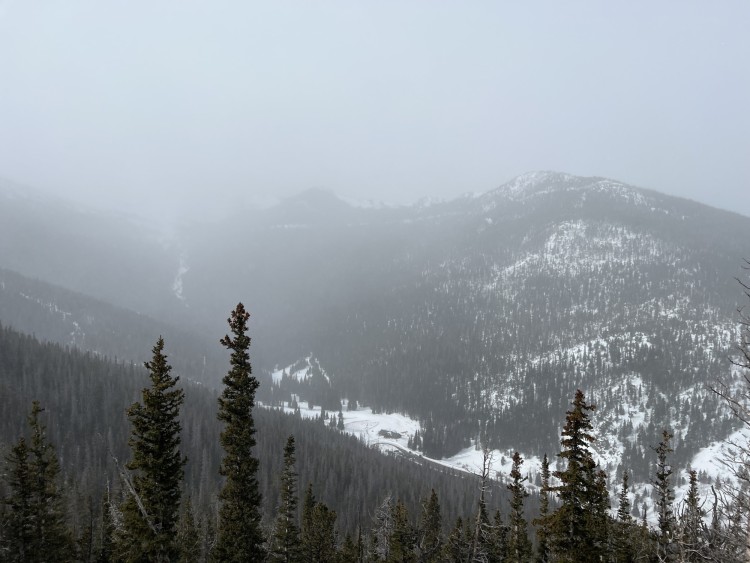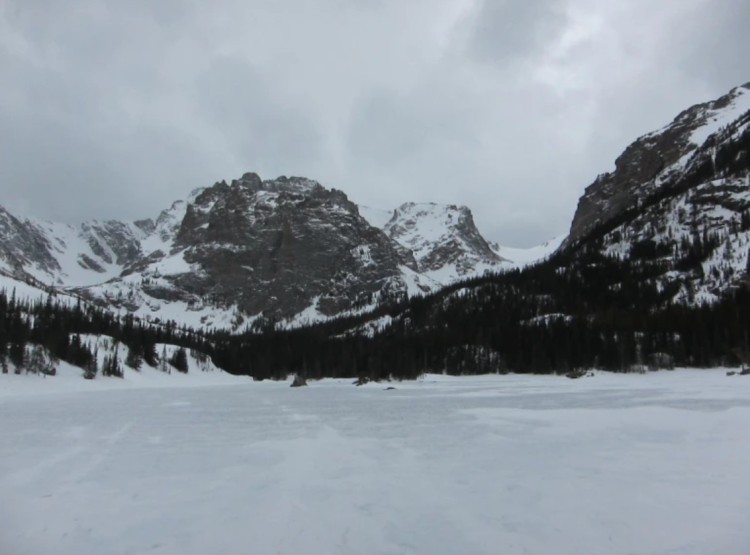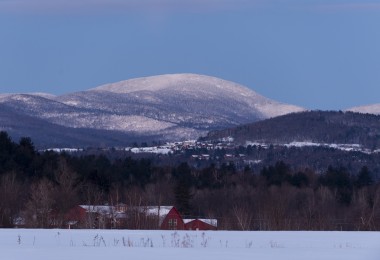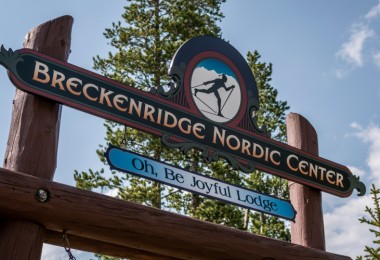With fresh snow crunching under the weight of my snowshoes, the wind-blown ice covering the surface of the lake comes into view. The frozen lake is a scenic foreground to the snow-covered mountains that serve as a picturesque backdrop.
Rocky Mountain National Park can be overlooked in the winter due to snowy roads and gale-force winds. However, with a little preparation and fortitude, this is one of the best parts of Colorado to explore with snowshoes on your feet.
In fact, Rocky Mountain National Park is home to some of the best snowshoeing in the country. From easy beginner hikes to difficult expert high-altitude trials, the national park has great trails for all skill levels, with more than 300 miles (483 km) of trails throughout the 265,807-acre park.
We headed up to Rocky Mountain National Park and strapped on our snowshoes to scope out some of the best trails around. Here learn what to expect and a few of the best snowshoeing trails Rocky Mountain National Park has to offer this winter.
Some of the links in this article may contain affiliate links. When you purchase using these links, part of the proceeds go to Snowshoe Mag. Additionally, as Amazon Associates, we earn from qualifying purchases. Please see our disclosure for more details.
What To Expect
Often the trails in Rocky Mountain National Park offer spectacular views of the Continental Divide, frozen lakes, or pristine snow-covered valleys. It is a treasure trove of scenic trails and spectacular vistas in the winter.
Some of the park’s roads and services are open in the winter, but make sure that you come prepared for high alpine snowshoeing. Carry plenty of layers and water. Also, you’ll have to leave your pup at home since no pets are allowed in the park.
Furthermore, plan for rapidly changing weather and be prepared to navigate an array of bunny trails that split off through the woods. Check avalanche conditions. Carry a shovel, a beacon, and a probe if you venture into avalanche-prone areas. The Rocky Mountain National Park winter trail guides mark high-risk avalanche terrain. However, if you’d like to avoid avalanche areas, check with a park ranger for additional recommendations.
Read More: Why All Snowshoers Should Be Avalanche Aware (Even Beginners)

Plan for changing weather in the park and alpine conditions since many trails are 8,000 feet or higher. Photo: Susan Wowk
Easy Snowshoe Hikes
For those just starting out, check out these easy snowshoe trails in Rocky Mountain National Park.
Hidden Valley
Serving as an old ski area in the park, today Hidden Valley is a nice sheltered area tucked off Trail Ridge Road. The base of the area includes a sledding hill that is popular with children and families. Snowshoers can choose their own adventure as there are an array of trails that wind their way out of the valley.
The lower sections are easy flat trails and terrain through the forest that provide great views of the valley. As you venture higher up the trails coming out of the valley, it gets a bit steeper, but the higher you climb, the better the views. Those who are ambitious can snowshoe to the top of the valley, but that would make this a harder hike.
Read More: 10 Tips for Making Snowshoeing Fun With Kids

Hidden Valley was the old ski area of the park and is now filled with a sledding hill and an easy beginner trail. Photo: David Young
Bear Lake
One of the more iconic beginner snowshoe areas to check out in the park is Bear Lake. The frozen lake, at more than. 9,000 feet (2743 m) offers an epic backdrop to start snowshoeing. The short well-trafficked trail that skirts the lake will provide amazing views in any direction. And once you are confident, the lake is a jumping-off point for some longer, harder hikes. This trail is a popular one, even in winter, so expect to see other snowshoers out there too.
Read More: Denver, CO: Top Day Trips for Snowshoe Beginners
Sprague Lake
This lake offers a scenic area to explore on snowshoes. There is a well-established trail that goes around Sprague Lake, and you can venture off here or there into deep snow drifts to make it a bit more adventurous and navigate deeper snow. The view in any direction here is amazing, and you can go as far or as short as you want to. It is a relatively flat area and a great starting place for beginners.
Read More: Definitive Guide: How To Choose Snowshoes for Your Needs
Moderate Snowshoe Hikes
If you’d like to test the waters (or snow) a bit, try these moderate trails with your snowshoes.
Nymph Lake
One trail to explore from the Bear Lake trailhead is Nymph Lake. The trail is just over a mile (1.6 km) roundtrip and has minimal elevation gain at 245 feet (75 m). The frozen lake in the winter provides a spectacular view of Hallett Peak, which stands at 12,720 feet (3877 m) in elevation. This is a great stepping-stone hike with a view for snowshoers looking to improve their skills.
Read More: Midwest Snowshoer to Colorado’s Rocky Mountain National Park
Emerald Lake
A high alpine lake that is frozen in time for the winter, Emerald Lake, is 3.6 miles (5.8 km) round trip and has about 600 feet (183 m) of elevation gain. The moderate snowshoe trek to the lake provides breathtaking views of the park. This is a popular trail year-round, so expect to see other snowshoers in the area.
Read More: Winter Photography Tips for Snowshoers
Ouzel Falls
What’s better than frozen waterfalls in the winter? The hike to Ouzel Falls offers some great moderate snowshoeing to some 40-foot (12 m) frozen waterfalls. The 5.5-mile (8.8 km) round-trip trail has less than 1,000 feet (305 m) in elevation gain.
The trailhead starts at Wild Basin and takes you through a snow-covered forest leading up to the falls. On windy days especially, this forest provides excellent cover from the gusts. In addition, there are several other falls and trails in this area if you opt to expand your hike after your falls.
Read More: What To Bring When Snowshoeing: Top Accessories for the Day Hiker

Wild Basin has several beautiful snowshoe hikes through the forest, including up to Ouzel Falls. Photo: Susan Wowk
Difficult Snowshoe Hikes
For those looking for a challenge and workout, try snowshoeing these difficult routes in Rocky Mountain National Park. If snowshoeing these routes, check out RMNP’s safety tips.
Flattop Mountain
Flattop Mountain is a long climb through the trees to a wide-open mountain top that is near the Colorado Divide Trail. It is nearly 9 miles (14.5 km) roundtrip and 2,850 feet (868 m) in elevation gain. The work is well worth it as the views at the top offer panoramic photos of the entire park. Just be prepared for wind, long miles, and elevation on this trail that starts at Bear Lake.
Read More: Safety First: Snowshoeing Hazards and How To Avoid Them
Chasm Lake
One of the harder hikes in the park, regardless of the season, Chasm Lake is located below Longs Peak and offers one of the best winter views in the entire Rocky Mountain National Park. The snowshoe trail is around 8 miles (12.9 km) roundtrip and has nearly 2,500 feet (762 m) of elevation gain. The frozen lake sits below the famous Dimond face of the fourteener Longs Peak.
Read More: Why You Should Use Snowshoes on Your Next Mountaineering Adventure
The Loch
The Loch is a high alpine lake in Rocky Mountain National Park near Andrews Glacier and Taylor Glacier. It is a 5.7-mile (9.2 km) snowshoe trek with 1,050 feet (320 m) in elevation gain. The views from the frozen lake are something right out of a postcard. This trail is located at the Glacier Gorge Trailhead.
Read More: How a Difficult Snowshoe Hike Makes You More Resilient
No matter what trails you select to snowshoe or end up exploring in Rocky Mountain National Park, you really can’t go wrong. This is just the beginning of trails to explore in this amazing part of Colorado. So grab your snowshoes and get ready to hit the trail!
Read Next: 11 Reasons To Visit Estes Park, Colorado










Leave a Comment